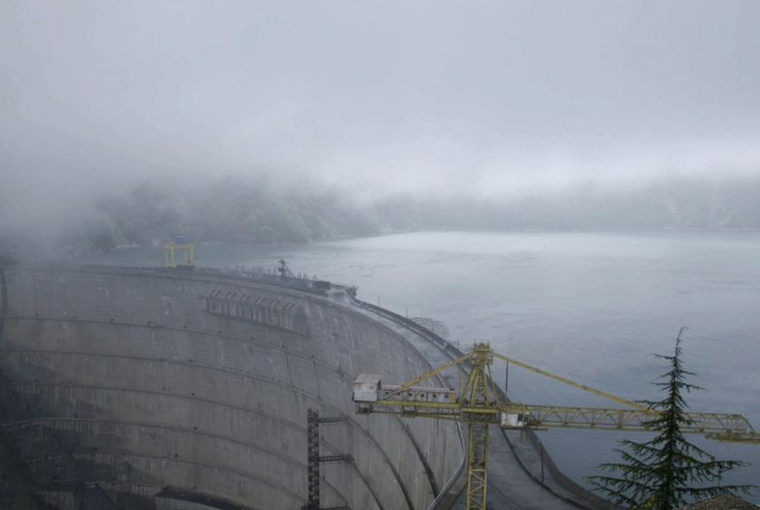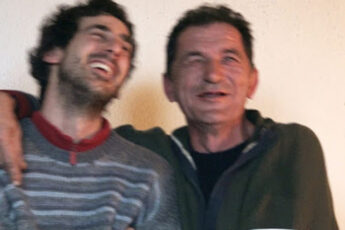Waiting for Abkhazia
Maradia Tsaava’s Water Has No Borders (Tskals sazghvrebi ar akvs, 2021)
Vol. 119 (November 2021) by Zoe Aiano
Despite the visual drama of the unfathomably huge Engari dam, which forms the central focus of the documentary Water Has No Borders, the film transpires to be less concerned with water and more with borders, which are in fact very present. Straddling Georgian and contested Abkhazian territory, the dam provides electricity for both states, forcing them to cooperate despite the fragility of the political context.
Filmmaker Maradia Tsaava is brought to the dam because of work, yet seems relatively uninterested in it until she unexpectedly befriends Irakli, a worker whose life seemingly revolves around the dam. Although he explains the mechanics of its operations to her, it isn’t until he discloses that many workers pass through the otherwise impenetrable border on a daily basis that her interest is truly piqued. Given this introduction to the location, both for the director and the viewers, it is unsurprising then that the film ends up foregrounding the human dimension of a resource management issue and the dam itself essentially ends up as a very unusual backdrop.
As the filmmaking process enters its next stage, Irakli stays on as the main protagonist and ends up acting both as Tsaava’s guide and fixer. Jovial and warm-hearted, his relationship with Tsaava (who also frequently appears in the film, especially at the beginning) is clearly not only central to the film in terms of dramaturgical continuity but also, perhaps more crucially, with regard to ensuring that production is able to continue at all in a practical sense. Indeed, the filmmaking process itself is revealed to an unusual extent. Unabashedly exposing her pushiness and determination, Tsaava is often shown navigating the various bureaucratic hurdles preventing her from achieving her goals, either directly or through Irakli. In one particularly amusing scene, she heckles him to make calls for her despite him being massively hungover, but the two of them end up laughing over it together (and he dutifully makes the necessary phone calls).
Tsaava’s obsession with crossing into Abkhazia quickly becomes the driving force of the film, as she gets stuck in a seemingly endless cycle of being stopped at the border, being rescued from the checkpoint by Irakli and resubmitting paperwork to try to improve the chances of success for the next attempt. As such, much of the film is given over to dealing with bureaucracy and waiting. While this sounds boring – and occasionally is and certainly must have been for the crew at the time – the benefit that comes from it is that Tsaava is forced into developing a different relationship with the dam infrastructure than she otherwise would have.
Ironically, or perhaps rather fittingly, the beating heart of the massive construction, at least in Tsaava’s depiction of it, turns out to be its small, run-down canteen. By loitering with the core of old ladies usually found there, Tsaava starts to hear first-hand accounts of how it is to live in a recently divided region, including stories of families separated, displaced, and dispossessed. Bit by bit, harrowing stories of cross-border traumas creep into the film, as do news of recent killings, demonstrating that the conflict is far from resolved.
Filmically, Water Has No Borders is something of a mishmash. The more or less first-person perspective of the interactions and the failed border crossings is combined with a fairly half-hearted effort to feign an interest in the practical workings of the damn. Part of this inevitably plays on the scale of the site, which, equally inevitably, implicates drone footage. However, the shots that are actually much more technically impressive and visually intriguing in this regard come whenever the cameraman films the terrifying descent down the rickety stairs that lead down the sheer concrete face into the abyss of the water. Finally, the film also takes a more expressive turn in the later stages, when the inclusion of narratives told through sound recordings – presumably for the sake of anonymity – necessitates some kind of visual material to accompany them.
Although fairly rough in places, the film remains engaging throughout and is likely ultimately stronger for not having achieved its original intention, despite how frustrating it must have been for the whole team. Of course, we can never know what Tsaava would have filmed if she had actually managed to make it into Abkhazia, but it most likely would have come at the cost of human connections she establishes, which end up being the film’s greatest asset. Certainly, she does a very impressive job of salvaging the situation and bringing out the best of the material rather than trying to shoehorn it into a pre-formulated concept.




Leave a Comment